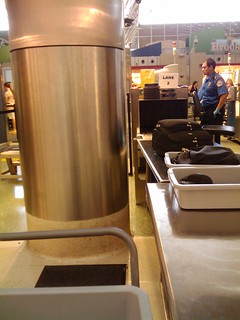QuickPanel: Air Travel
Must it be so miserable? Cheap fares and favorable weather may be outside the reach of good design, but surely some aspects of the flying experience could benefit from a little UX love. We asked a few of our experts how to make trips to the friendly skies more user-friendly.
What are airports doing, and what can they do, to become nicer places to spend time?
The reason why we have so many bad experiences… is that the parts in between are not designed at all.
 Andy Polaine: We talk a lot in service design about the transitions between touchpoints being as important as the touchpoints themselves, if not more so. The reason why we have so many bad experiences—even with services whose individual parts seem well-designed (think of even good airline websites and check-ins)—is that the parts in between are not designed at all. Those dead spots don’t have to be filled with entertainment and lots of noise, but they could be way better than standing in a long queue in very dreary surroundings.
Andy Polaine: We talk a lot in service design about the transitions between touchpoints being as important as the touchpoints themselves, if not more so. The reason why we have so many bad experiences—even with services whose individual parts seem well-designed (think of even good airline websites and check-ins)—is that the parts in between are not designed at all. Those dead spots don’t have to be filled with entertainment and lots of noise, but they could be way better than standing in a long queue in very dreary surroundings.
One example of this is the security area in Göteborg Landvetter Airport in Stockholm, which is decorated like a nice hotel foyer, as you can see in this photo I took. (I rushed the photo because I’ve gotten so used to the idea that I might get arrested for taking out a camera in security, although probably no one would have minded. There’s an article and another photo here.) It still has X-ray machines and scanners, but they’re clad in white instead of jailhouse grey; it’s actually a pleasant environment to wait in and doesn’t make you feel like a criminal. I think a lot more could be done to encourage that third space downtime rather than trying to use it to force more stuff onto us.
(I rushed the photo because I’ve gotten so used to the idea that I might get arrested for taking out a camera in security, although probably no one would have minded. There’s an article and another photo here.) It still has X-ray machines and scanners, but they’re clad in white instead of jailhouse grey; it’s actually a pleasant environment to wait in and doesn’t make you feel like a criminal. I think a lot more could be done to encourage that third space downtime rather than trying to use it to force more stuff onto us.
 Mike Fisher: To Andy’s point, one of the recommendations I made to [an airline I consulted for] a while back had to do with making their gates more pleasant and traveler-friendly. Fortunately for all of us, in the last few years some airlines have begun to look at their gates as part of the overall experience—in some cases offering simple conveniences like power plugs, etc.—though I think overall they could go further.
Mike Fisher: To Andy’s point, one of the recommendations I made to [an airline I consulted for] a while back had to do with making their gates more pleasant and traveler-friendly. Fortunately for all of us, in the last few years some airlines have begun to look at their gates as part of the overall experience—in some cases offering simple conveniences like power plugs, etc.—though I think overall they could go further.
Some airports (Portland comes to mind) have done a good job of improving the experience of their public spaces and making them more relaxing and traveler friendly. Minneapolis’s Humphrey terminal has several areas set aside with restaurant booth-style seating areas with power. And at each of the terminal elevators they’ve thoughtfully placed pencils and notepaper for travelers to write down the location of their car.
Sadly, I have yet to come across a good TSA experience; they seem to be varying shades of awful.
Sadly, I have yet to come across a good TSA experience; they seem to be varying shades of awful. Even if we assume that body scanning is necessary (I certainly don’t think so, but that’s a different conversation), there’s plenty of room for improvement in terms of logistics and basic service design. For example, at the U.S. airports I’ve seen there appears to be no system in place to quickly respond to increased passenger flow by bringing more agents online to check boarding passes. I suspect they have some system for this, but if they do, it’s not adequate. Instructions could be better, too. I’ve watched a lot of novice travelers get caught up in various shoe/belt/laptop/toothpaste conundrums because the rules are explained inconsistently or not at all.
 Indi Young: The airline I consulted for seemed to think that the “club” lounges were what they should concentrate on. We heard quite a bit from passengers about both gate and lounge experiences. There was a lot of frustration expressed by people hoping to use the lounge but being refused entry. (The airline has very complicated policies regarding when passengers can use the lounges.) But the airline was putting effort into its lounges and its check-in process, not the gate experience.
Indi Young: The airline I consulted for seemed to think that the “club” lounges were what they should concentrate on. We heard quite a bit from passengers about both gate and lounge experiences. There was a lot of frustration expressed by people hoping to use the lounge but being refused entry. (The airline has very complicated policies regarding when passengers can use the lounges.) But the airline was putting effort into its lounges and its check-in process, not the gate experience.
…they ignored our findings because they’re not used to investing in something that doesn’t directly return a profit.
I think they ignored our findings because they’re not used to investing in something that doesn’t directly return a profit. Investing in improving the “dead spots,” as Andy put it, would result in more passengers choosing that airline, but that isn’t a directly connected profit. At least that is what I think their reasoning is; I was blocked from speaking with the decision makers. (I’m still trying.) Oddly, the airline was also interested in creating a vacation-choosing service. None of the 100 people we listened to needed help figuring out where to go on vacation, but I think our findings fell on deaf ears. Someone higher up was excited about lounges and vacation-choosing services, and so that’s what was happening.
Meanwhile, as a contrast to Andy’s photo of Göteborg Landvetter Airport, here’s one I snapped (surreptitiously, for the same reasons) of an obstacle passengers have to navigate to get through security in San Antonio International Airport.
A lot of people may not realize that airports’ customers are, in fact, airlines, not passengers. How does this impact airports’ attitudes toward the people who flow through their space?
Indi Young: In my year-plus with [a major airline], I found out they have an “attitude” about the airports. Airports aren’t owned by them, and any physical upgrades, especially infrastructure upgrades, are done by the airport itself. It’s kind of like leasing office space. You do your own decor, but most of the stuff is already in place. (Seats, doors, windows, carpet, outlets, etc.) You could negotiate for some upgrades, but somehow the attitude is to not prod that sleeping dog.
Andy Polaine: Yes, this will be news to a passenger who has spent anything between a few hundred to a few thousand dollars on tickets, only to be treated like a criminal at best and mindless shopping robot at worst. It is an example of a broken, reverse or negative service ecosystem from the customer perspective.
…it’s not about an ongoing relationship, but selling someone a ticket and getting out of the relationship as quickly as possible…
It’s also a great/bad example of how the cracks between the different service providers aggregate to form an experience crevasse. Each provider or department believes it’s someone else’s job to deal with experience X (the “attitude” Indi mentioned). I’m sure, if it was about branding, the airlines would put pressure on the airport to change the decor. When it is about passenger experience, they don’t have to bother because they’ve already got your money. That’s what happens when a service is sold with a product mentality—it’s not about an ongoing relationship, but selling someone a ticket and getting out of the relationship as quickly as possible with the minimum amount of commitment.
Why is there such a difference between countries in the quality of air travel?
Andy Polaine: There are some real differences that are, in my experience, usually cultural clichés but relatively true. I recently experienced the difference between Germany’s Lufthansa and Singapore Airlines on my way to and from Australia. Same planes; very different cultures of service and ambience. Singapore was very much about warm service; Lufthansa was efficient and not unfriendly, but a little bit withheld. These are small generalizations, and I’ve experienced the opposite on both airlines, but this was my overall experience.
There are also cultural norms in the sense of what passengers have been educated to put up with. I see Americans taking their shoes off for the X-ray machines as a matter of course, even though they’re not required to. They’ve just clearly gotten used to having to go through such a rigamarole with TSA.
Mike Fisher: I traveled to Tel Aviv on El Al a couple of years ago and found both the in-flight and in-airport experiences fascinating. El Al not only served reasonable food (at least by American standards), they left plenty of snacks in the galley area and encouraged passengers to “graze” while stretching their legs during the long flight. I think on a U.S. flight you’d be either admonished or tackled for taking food from the galley without explicit permission.
…in Tel Aviv, the security agents couldn’t care less if you have a bottle of water or a tube of toothpaste with you…
At Ben Gurion Airport in Tel Aviv, the security agents couldn’t care less if you have a bottle of water or a tube of toothpaste with you (in fact they laughed when I asked if I should throw it away). Instead they watch expressions, body language, and other factors that can reveal a potential troublemaker. They achieve a very high level of security with a relatively small staff, and without wasting resources the way TSA seems to. Baggage gets scanned by machine but people receive individual scrutiny. It’s a smart system and in my view far less invasive than what we’ve become used to with the TSA.
Indi Young: In the U.S. sometimes the flight attendants are not completely on board with the airline, if you will allow me that euphemism. Flight attendants often belong to a separate organization that frequently fights with management. I’m not sure about gate and counter personnel, but in all cases, it’s these employees who interface with passengers the most. Again, attitude plays a big role, whether positive or negative. The passengers I listened to didn’t tell stories about differences in countries (except Amsterdam’s airport, which apparently draws everybody’s ire). They did tell stories about individual personnel members who treated them with great suspicion—assuming that this passenger was thinking the worst or being greedy, and letting that assumption influence their treatment of this passenger.
…we were unable to get the higher-ups interested in a study involving gate personnel or flight attendants.
In our research, we were unable to get the higher-ups interested in a study involving gate personnel or flight attendants. The one flight attendant that I got to listen to at length is a purser on international flights—she’s in charge of all the personnel on the plane, except the captain and others on the flight deck. She even complained about the attitude the flight attendants had: “I’d rather be serving the masses than catering to the asses.” Or vice versa. She implied that flight attendants (clearly not all of them) either prefer to work in Economy and deal with passengers’ uppity demands with a level hand, or to serve in Business or First Class, where the demands are at least valid, because passengers have paid more, but they tend to treat flight attendants like servants. You can begin to see where flight attendants, and gate personnel, come from; they don’t like being treated like servants. They don’t like being asked for extra services that aren’t a part of their normal work process. They try to limit their interaction with passengers and treat everyone with their own rote style of interaction. One flight attendant told me, “I’m only here for safety.” Of course, this is not true of everyone. I wish I’d been able to hear from the gate personnel and flight attendants. But to answer the question, the differences in treatment come more from the attitude of the personnel, based on their work conditions and how they personally handle dealing with hundreds of passengers a day. Many airlines don’t seem to have any strategy around this. Some do.
Like what our experts had to say? Guess what: you can have them bring their brains to you. Mike Fisher, Andy Polaine, and Indi Young are available for consulting and training through Rosenfeld Media.
Reaching beyond the English-speaking market
Since our site launched last month, Rosenfeld Media has been mentioned in a number of non-English web sites. It’s wonderful to make even the tiniest dent around the world; it’s also wonderful to see how Google’s automatic translation service renders these postings.
Survey seminar: resources and slides
Thanks to everyone who attended my Virtual Seminar “Designing effective surveys” on 28th February 2012.
If you missed it, you can:
- purchase the recording from User Interface Engineering
- view the slides on SlideShare (or at the end of this post)
Resources that I mention in the seminar
Three reasons why your response from your panels may not be what you want
What might turn an honest, happy respondent into a despondent cheat?
User experience and the analysts
As part of our ongoing research of the UX environment, we recently took a closer look at the six major analyst firms (Aberdeen, AMR, Forrester, Gartner, IDC, and Yankee). We were hoping to determine if the analysts were paying much attention to user experience, so we searched a variety of UX-related terms (21, to be precise) on their respective web sites. We then looked at which firms paid attention to which UX topics, how these firms stacked up against each other, and how they compared to the web’s overall UX consciousness.
Design in Product 2023 Full Program Announced
We’re excited announce the full program and workshops lineup for Design in Product 2023! On November 29-December 1, these experts will take the stage to tackle real questions and discussions surrounding the design and product fields.
What is Design in Product 2023 about?
Design in Product is a conference dedicated to the intersections of—you guessed it—Design and Product. Whether you’re moving into a product role, or looking to be a better partner with product peers, Design in Product will prepare you for success in product-centric organizations.
This year’s conference is centered around three themes.
- Aligning and partnering—Nailing the basics of alignment and partnership are table stakes for getting past the friction that often plagues the PM/UX relationship.
- Setting and defending priorities—Product managers and UX practitioners need to work together to set priorities, develop roadmaps.
- Influencing and politcking—Product managers seem to have mastered the trick of influencing without authority. Can UX practitioners learn to do the same?
Who are the keynote speakers for Design in Product 2023?

Ellen Chisa is a Partner at boldstart ventures investing in enterprise infrastructure, SaaS, and developer tooling companies. Before joining the boldstart team in January 2021, she was the CEO & co-founder of Dark (https://darklang.com) a programming language coupled to its editor and infrastructure.
Her opening keynote, The Values of Design, has the aim of answering questions such as “How can I create more business impact, while still feeling like a designer?”

John Cutler focuses on the messy overlaps and patterns of product—The Beautiful Mess (the title of his newsletter). John currently supports product teams at Toast as Senior Director, Product Enablement. Before Toast, he interacted with diverse product teams and product leaders worldwide as a product evangelist and coach at Amplitude.
John will close out this year’s conference with his keynote, The Alignment Trap, where he will explore what alignment really means in the context of complex unpredictable work.
Who else is speaking at Design in Product 2023?

Asia Hoe is a Senior Product Designer and a multidisciplinary product design leader who brings her obsession with detail and systems thinking to product development and design systems for organizations tackling today’s biggest issues in health, education, and society.
Her session, Partnering with Product: A Journey from Junior to Senior Design, will dive into our product designers and product managers can play to their strengths and find a way to meet at the focus of the products: the users.

IHan Cheng, Design Manager at Compass Digital, is an experience orchestrator who thrives in ambiguities and currently works as a Design Manager at Compass Digital. IHan blends optimism with practicality, excelling in bridging ambitious visions with viable executions.
You will be able to see her at #DiP2023 co-presenting the session, Design and Product: from Frenemy to Harmony with Iain McMaster.

Iain McMaster is the Director of Product at Compass Digital as well as an experienced Product Leader in the Food Technology industry. With a solid background in product development and a passion for innovative solutions, Iain brings a unique blend of expertise, collaboration and humor to every endeavor.
Iain will be co-presenting the session, Design and Product: from Frenemy to Harmony with IHan Cheng.

Laureen Kattan is a Principal Product Manager at Coforma with a decade of experience in product management across the financial and government services sector.
Laureen will be co-presenting alongside Julie Kim in the session, Centering Patients and Clinicians in a Complex Government Ecosystem, where she will discuss how to navigate challenges and foster success in support of the Department of Veteran Affairs (VA) and its goal to relieve over-burdened clinicians and improve patient care.

Julie Kim is a civic-minded product designer, writer and maker. She leverages her past experiences in architecture and urban planning to bring unique perspective to her current digital design practice. Currently, Julie works at Coforma as Senior Product Designer.
Julie will speak alongside Laureen Kattan at the session, Centering Patients and Clinicians in a Complex Government Ecosystem—a talk about strategies for prioritization within a complex ecosystem of business owners, and centering patients and clinicians through a strong UX/Product partnership.

Dr. Chloe Sharp has over a decade of experience in research and has been a co-founder of a research and grant-writing consultancy working with multiple startups, scale-ups and SMEs across different stages of the product development lifecycle. She currently works as a Product Research Consultant and Coach at Sharp Insight.
Her talk, Using Evidence and Collaboration for Setting and Defending Priorities, will explain how UX Research and Product Teams can collaborate to identify innovation opportunities and develop products and services customer and users need.

Alfred Kahn is a strategic, outcome-focused design leader skilled in helping companies achieve business goals while navigating data-rich, complex problem spaces. He works at 84thomas as a Design & Strategy Consultant.
Alfred will be presenting the talk, A Seat at the Table: Making Your Team a Strategic Partner, will explore the ways Design can transition from being seen as a tactical resource to being seen as a strategic partner.

Shan Shen leads the product design experience in the e-commerce space, currently as a Principal UX Designer at Custom Ink. Her role is to empower customers to create unique custom products that foster deep engagement with their communities and promote their cause. She creates products and fosters a collaborative space where great ideas can thrive and make a difference.
At #DiP2023, Shan will highlight instances where UX terms consistently hinder collective problem-solving between UX and product teams at her session, Translating UX Terms into Business Contexts.
If you’re interested in viewing the full conference program, click here!
Will there be workshops at Design in Product 2023?
The short answer is YES! Following the conference on November 29, we will be offering two virtual workshops across two days. These workshops combine the cutting edge expertise of some of the world’s leading product and UX experts with the same high quality that people love about Rosenfeld Media’s books and conferences. Here are a few of the reasons why those at #DiP2023 are worth attending…
Great topics such as metrics and design for SaaS

Catt Small will be leading Saas Design Strategy Intensive: Stop Being a Paintbrush, Start Being a Visioner. In this workshop, you’ll learn and practice techniques to become a more strategic SaaS designer. Catt Small, an industry leading Staff Product Designer, will draw on her experience at Etsy, Soundcloud, and Asana to help you identify and navigate the political roadblocks that keep many designers stuck in the ideological playpen at SaaS companies. You’ll form alliances with designers from across the industry in the fight for better product decisions and higher-quality user experiences.
Who is this workshop for
- Senior Designers who want to make a substantial and meaningful impact on products and their subscribers
- Staff and Principal Designers who want to truly be heard, not just seen by peer functions
- Lead Designers who are frustrated by being left out of important decisions that affect their work

Adam Thomas will be leading Survival Metrics. In this workshop, you will learn to implement faster cycles of decision-making, interpret data collectively to increase confidence and build trust, clarify company values enough to model them in your team’s work, convince teams to change direction when necessary, learn how to turn strategy into something usable, and leverage data-informed decision-making.
Survival Metrics is a framework that helps teams find clarity in their strategy, use metrics to create a culture of data-informed decision-making, and build trust in the product organization so change doesn’t feel as risky. Survival Metrics clarifies the way forward, transforming the specter of change from a bogeyman into a boon.
This workshop will outline how product teams can leverage the three pillars of survival — being fast, data-informed, and politically safe — to plan for change to avoid ambiguity and get all stakeholders excited to move forward.
Pre-requisites
- A basic understanding of the creation of product (product engineers, product designers, product managers)
Who is this workshop for
- Product managers, product designers, product engineers who are struggling to adjust and operationalize strategy in the market
We have wise instructors—Catt Small and Adam Thomas

Catt Small is a product design leader, game maker, and developer who has 13+ years of experience working with companies of all sizes including Asana, Etsy, and SoundCloud. She is currently designing a more enlightened way of working at Dropbox. In her spare time, Catt makes awkward video games, writes, and draws artwork of all kinds. You can view her work on her website.

What can we learn by following our curiosity, embracing the unknown, and creating amidst chaos?
This is the question that propels Adam Thomas’s career as a technologist, product expert, and all-around thinker and creator. His answer so far? We can learn that our potential is limitless and we have an amazing array of options for living, working, and playing better.
Seizing every opportunity to dive deep into these topics and more, Adam regularly holds his signature workshop on product strategy, management, and leadership, publishes his newsletter on all things tech- and product-related, and is frequently booked as a speaker on podcasts, conferences, and other forums dedicated to bright ideas and big possibilities.
A humane schedule
We know there’s only so long you can remain engaged in a workshop. That’s why we spread it out across two days. Our virtual workshops will take place over two 4-hour sessions on November 30-December 1. From 9:30am to 1:30pm PT, our workshop instructors will be connecting with you virtually to host their lectures, activities, and more! Four hours across two days for one workshop of your choice.
Interested in attending? Register today!
AI is the future of UX. Here’s how to prepare.
As 2025 continues, it’s clear that artificial intelligence (AI) has become more than just another buzzword. It’s reshaping the landscape of user experience (UX) design. In fact, there are many exciting opportunities arising in the UX field because of advancements made with AI. But how do we navigate this shift toward an AI-oriented future while also being mindful of its shortcomings? We’ve got you covered with this quick rundown on the state of AI, UX, and how we can best prepare for the future.
The AI Revolution in UX Design
AI is transforming the way we approach UX design—that much is clear. Let’s explore a couple of ways in which we can harness its potential while staying mindful of its limitations.
Personalization and Predictive Analytics
AI’s ability to analyze vast amounts of data is revolutionizing personalization in UX design. By leveraging user behavior, preferences, and past interactions, we can create hyper-relevant experiences that drive engagement and conversions. AI-powered predictive analytics can anticipate user needs, allowing us to design smoother and more intuitive user journeys.
That being said, we must be cautious of the potential for bias in AI systems. The training data used by large language models can perpetuate stereotypes and reinforce prejudices, leading to skewed results and poor decision-making. It’s essential that we evaluate AI-generated insights through a critical lens and ensure diverse perspectives are considered in our design processes.
Automation and Efficiency
One of the most exciting aspects of AI in UX design is its potential to automate repetitive tasks, freeing up our time to focus on more strategic and creative aspects of design. AI-powered tools can help with tasks like data analysis, layout generation, and color scheme creation, streamlining our workflow and improving productivity. Just think of the amount of tools and resources that are now cropping up to help us with just that!
Challenges and Ethical Considerations
There’s lots of excitement surrounding AI, but as with any technological advancement, there are potential drawbacks we must stay on top of.
Privacy and Data Security
The use of AI in personalizing user experiences, especially in terms of how these models are trained, raises important privacy concerns. Handling user data responsibly and obtaining proper consent is more important than ever. Striking a balance between personalization and data protection will be an ongoing challenge as AI becomes more integrated into our processes.
Emotional Intelligence and Human Touch
While AI excels at data analysis and pattern recognition, it still struggles to fully understand human emotions and cultural nuances. This limitation can lead to designs that lack empathy and fail to connect with users on an emotional level. It’s the human touch that’s so crucial in creating meaningful user experiences. UX designers, we can’t let AI take this away.
Overreliance and Critical Thinking
As AI tools evolve, we run the risk of becoming too reliant on artificial intelligence. We’ve seen examples in other fields, like healthcare, where excessive trust in AI recommendations has led to errors and concerns about reliability. In fact, you may have seen recent study by Microsoft about how reliance on artificial intelligence raises concerns of reduced critical thinking and creative problem solving. It’s crucial that we maintain our critical thinking skills and use AI as a tool to augment our decision-making, not replace it entirely.
Preparing for the AI-Powered Future of UX
To thrive in this AI-driven landscape, here are some steps we can take:
- Embrace continuous learning: Stay updated on AI advancements and their applications in UX design. Attend events like Designing with AI 2025 to keep yourself in the loop and uplevel your AI know-how.
- Develop a critical eye: Learn to evaluate AI-generated outputs critically. Understand the limitations of AI tools and when human intervention is necessary.
- Focus on ethical design: As AI becomes more prevalent, prioritize ethical considerations in your design process. Be mindful of privacy, bias, and inclusivity.
- Collaborate and share knowledge: Engage with the UX community to share experiences and best practices for integrating AI into design workflows. Our network of over 14,000+ user experience designers is a good place to start.
As we navigate this AI-powered future, it’s essential to approach it with both excitement and caution. By leveraging AI’s strengths while being mindful of its limitations, we can create more innovative, efficient, and user-centered designs. The future of UX is here, and it’s up to us to shape it responsibly.
P.S. Don’t forget to check out Rosenfeld Media’s second annual Designing with AI 2025 conference. It’s going to be an awesome opportunity to learn, network, and get inspired about the future of UX and AI. See you there!
Search analytics “Book in Progress” site now live
We’ve just launched a web site for Lou Rosenfeld and Rich Wiggins’ forthcoming book, Search Analytics for Your Site. You’ll find a draft of the book’s first chapter, a free Perl script that generates a report from search logs, a bibliography, and much more. The site is also a place to ask questions, discuss, and share your experiences using search analytics on your own site.
Please have a look and let us know what you think, and keep up with the site’s news and announcements by add this RSS feed to your aggregator. We plan on adding lots of new content in the coming months.
Something new: Rosenfeld Media communities
Announcing Rosenfeld Media Communities!
We’re in the content business—but let’s face it, the best content is an artifact of the conversations we are already having in our professional communities. Conference programs, books, workshops—all are simply polished versions of the conversations we’re already having.
That’s why Rosenfeld Media began facilitating three communities—covering DesignOps and ResearchOps, Enterprise Experience, and Advancing Research—over a year ago. Through monthly videoconferences and other means, dozens of us have been sharing ideas, content, furthering practices, and learning together in a fun and informal setting.
We’re now bringing these communities to the web and adding even more functionality. The first community site, for Enterprise Experience, just went live a few minutes ago, and the others will launch in the coming weeks. Best of all, our communities are free to join. We hope you will!
Talking DesignOps
You might know that, last November, Rosenfeld Media hosted the first conference dedicated to discussing design operations. The DesignOps Summit sold out, and we’re now planning a second edition for this fall in the US northeast.
You might not know that we’ve organized a free monthly conference call to keep the DesignOps discussion going. We’ve held two, and our last one had 60 participants. Next one is February 15, 4-5pm ET. We’d love to have you join us too; email [email protected] to request an invitation.

